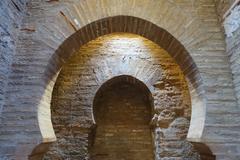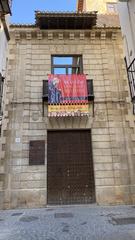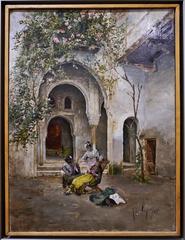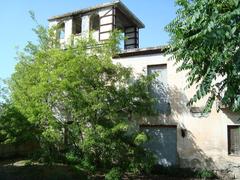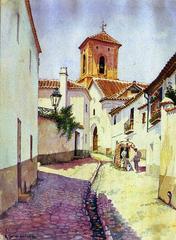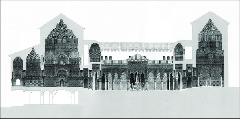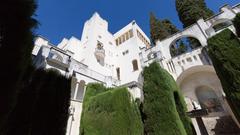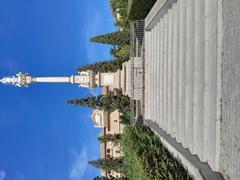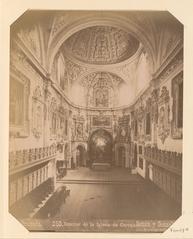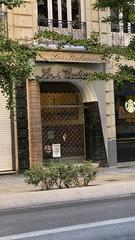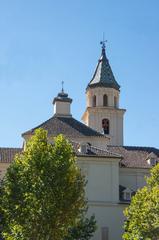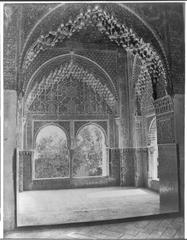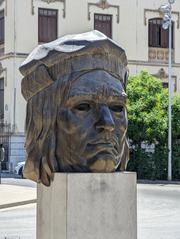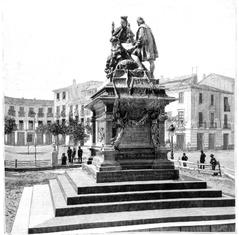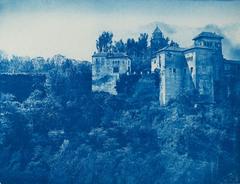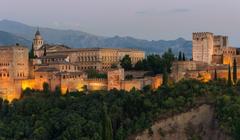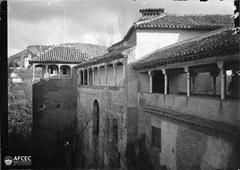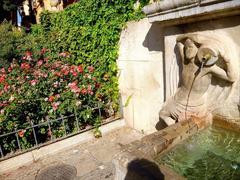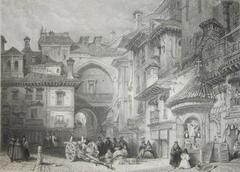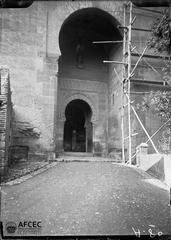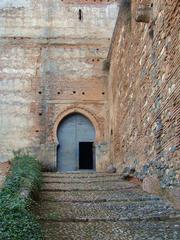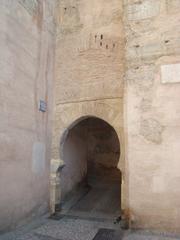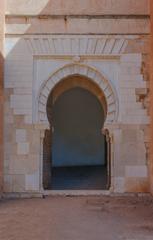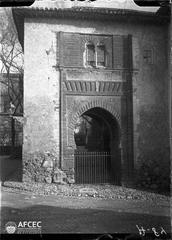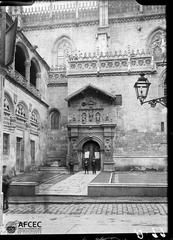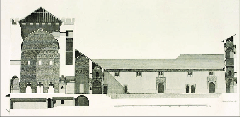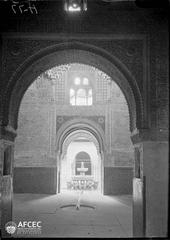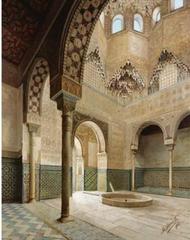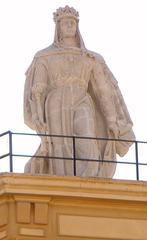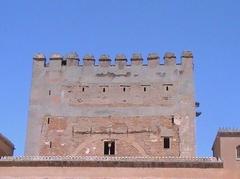Baño de Comares: Visiting Hours, Tickets, and Historical Significance in Granada
Date: 14/06/2025
Introduction
Situated within the iconic Alhambra complex in Granada, Spain, the Baño de Comares is a masterful example of Nasrid Islamic architecture and a living testament to Andalusian cultural heritage. This royal hammam, built for the Nasrid sultans, was far more than a place for bathing—it served as a center for ritual purification, socializing, and ceremonial life. Its unique architectural features, advanced technological innovations, and intricate decorative artistry highlight the intersection of Roman, Islamic, and Andalusian influences, making it one of Western Europe’s most significant medieval baths (visit-andalucia.com; visitasguiadasalhambra.online).
This guide explores the Baño de Comares’ historical context, architectural splendor, cultural significance, and provides practical information on visiting hours, ticketing, accessibility, and nearby attractions—equipping you to make the most of your Granada experience.
Historical Context
Early Origins and Islamic Granada
The Alhambra’s history dates back to early fortifications on Sabika Hill, possibly from the Roman era. The first written reference to a fortress here appears in the 9th century amid political unrest in the Caliphate of Córdoba. By the 11th century, the Zirid dynasty established the Taifa of Granada, setting the stage for the Alhambra’s transformation into a royal citadel (visit-andalucia.com).
Nasrid Dynasty and the Baño de Comares
The Baño de Comares was constructed during the reign of the Nasrid dynasty (1238–1492), the last Muslim rulers in Iberia. Under sultans like Yusuf I and Muhammad V, the Alhambra blossomed into a spectacular palace complex. The royal bathhouse mirrored the traditional Roman sequence of rooms—apodyterium (changing room), frigidarium (cold room), tepidarium (warm room), and caldarium (hot room)—but with distinctive Islamic elements such as star-shaped skylights and elaborate tilework. The baths were heated by an advanced hypocaust system, testament to the era’s technological ingenuity (ugr.es).
Symbolism and Function in Nasrid Society
More than a space for cleansing, the Baño de Comares functioned as a locus of social and spiritual life. Here, sultans and courtiers engaged in relaxation, political discussion, and ritual purification, surrounded by symbolic decor evoking paradise and divinity (ugr.es; nomads-travel-guide.com).
Christian Conquest, Adaptation, and Preservation
Following the 1492 conquest by the Catholic Monarchs, the Alhambra became a Christian royal residence. The Baño de Comares was preserved and restored in the 16th century by artisans such as Isabel de Robles and Arnao de Vergara, who maintained much of its original “exotic” character. Despite the construction of the Palace of Charles V nearby, the bathhouse survived centuries of change (ugr.es).
Decline, Rediscovery, and Restoration
Neglect in the 18th century and damage during the Napoleonic Wars led to deterioration. Restoration began in the 19th century under Rafael Contreras and continued through the 20th century, securing the Baño de Comares’ place as one of Europe’s best-preserved medieval Islamic baths (ugr.es).
Architectural Features
Layout and Spatial Organization
The Baño de Comares exemplifies the classic progression of rooms found in Islamic hammams:
- Apodyterium (Changing Room): Entry point for guests to undress and prepare.
- Frigidarium (Cold Room): Decorated with shimmering tiles and horseshoe arches.
- Tepidarium (Warm Room): Transitional space for acclimatization.
- Caldarium (Hot Room): Central steam chamber, heated by a hypocaust system.
This spatial sequence facilitated both ritual and physical cleansing, while the layout maximized privacy and serenity (visitasguiadasalhambra.online).
Structural and Decorative Elements
Notable features include:
- Star-shaped skylights: Piercing the vaulted ceilings, these skylights once held colored glass, casting ethereal light and aiding ventilation.
- Stucco and tilework: Intricate geometric and vegetal motifs, marble flooring, and glazed tiles showcase Nasrid craft mastery.
- Hypocaust system: An underfloor heating technique inherited from Roman baths, adapted with Islamic innovations (nomads-travel-guide.com).
Preservation and Authenticity
The Baño de Comares is the only medieval Islamic bathhouse in Western Europe to retain its original architecture and decoration. Restricted access, periodic restoration, and special events help protect its fragile features (granada.hammamalandalus.com).
Cultural Significance
Social and Ritual Role
Hammams in Nasrid Granada were vital hubs for socializing, religious purification, and even political discourse. The Baño de Comares, with its paradisiacal motifs and tranquil ambiance, embodied the concept of earthly paradise and the spiritual ideals of Islamic society (nomads-travel-guide.com).
Enduring Legacy
The influence of the Baño de Comares endures in modern Granada bathhouses, such as Hammam Al Ándalus, which blend historical design with contemporary wellness. The bathhouse is also a cultural icon, featured in art, literature, and academic research (granada.hammamalandalus.com).
Visiting the Baño de Comares
Visiting Hours and Tickets
- Access: The Baño de Comares is part of the Nasrid Palaces within the Alhambra. Due to its delicate state, direct access is often restricted; however, it can be viewed from adjacent rooms or during special events.
- Alhambra Complex Hours:
- April–October: 8:30 AM – 8:00 PM
- November–March: 8:30 AM – 6:00 PM
- Tickets: Advance online booking is strongly recommended due to high demand (official Alhambra ticket website). General admission is approximately €14, with discounts for certain groups (visitasguiadasalhambra.online).
Guided Tours and Audio Guides
Many guided tours and audio guides include the Baño de Comares, offering detailed commentary on its history and architecture. Special tours may grant limited access during “Space of the Month” events (nomads-travel-guide.com).
Accessibility
The Alhambra provides partial accessibility for visitors with limited mobility, but historic features may restrict access to some areas of the Baño de Comares. It is advisable to check accessibility details in advance.
Nearby Attractions
- Nasrid Palaces: Marvel at the intricacies of the Palacio de Comares and Palacio de los Leones.
- Generalife Gardens: Wander through lush Islamic gardens.
- Albaicín District: Explore a UNESCO-listed Moorish neighborhood with panoramic views.
Travel Tips
- Book tickets early to secure your visit.
- Arrive ahead of your entry time for a relaxed experience.
- Wear comfortable shoes due to cobblestone and uneven surfaces.
- Photography is allowed in most areas, but restrictions apply in sensitive zones.
Experiencing the Hammam Tradition in Modern Granada
Modern hammams, inspired by the Baño de Comares, provide an authentic wellness experience while preserving Andalusian cultural traditions.
Baño de Comares at Hotel Maciá Real de la Alhambra
- Location: Calle Mirador del Genil, 2, 18008 Granada.
- Hours: Daily sessions from 10:00 AM–2:00 PM and 5:00 PM–9:00 PM.
- Tickets: Book via the official hotel website; prices range from €30–€60, depending on the chosen wellness circuit.
- Facilities: Multiple pools (hot, cold, dynamic), Turkish bath, cryotherapy, massages, and tea room.
- Accessibility: Most areas are accessible; contact the hotel for details.
- Etiquette: Swimwear required, towels provided, quiet atmosphere maintained (hotelmaciarealdealhambra.com).
Hammam Al Ándalus and Other Modern Baths
- Hammam Al Ándalus: Open daily, offering sessions inspired by Nasrid traditions (granada.hammamalandalus.com).
- Booking: Advance reservations highly recommended.
- What to Expect: A sequence of hot, warm, and cold pools, optional massages, and tranquil relaxation (asinglewomantraveling.com).
Frequently Asked Questions (FAQ)
Q: Can I directly access the Baño de Comares?
A: Direct access is often restricted, but it can be viewed from adjacent Nasrid Palace rooms or during special events.
Q: How do I book tickets?
A: Use the official Alhambra website or authorized vendors for advance bookings.
Q: Are there guided tours?
A: Many guided tours include the Baño de Comares within the Nasrid Palaces route.
Q: Is the site accessible for those with reduced mobility?
A: Partial accessibility is provided, but some areas remain challenging due to historic architecture.
Q: Can I take photos?
A: Photography is permitted in most public areas, but not within modern hammams or sensitive historic spaces.
Summary and Recommendations
The Baño de Comares stands as a magnificent intersection of history, architecture, and cultural tradition within Granada’s Alhambra. While direct visitation may be limited to preserve its integrity, guided tours and adjacent viewing offer a window into its splendor. For those seeking an immersive experience, modern hammams in Granada—faithfully inspired by the Baño de Comares—deliver a blend of wellness and cultural connection (granada.hammamalandalus.com; hotelmaciarealdealhambra.com).
Plan your visit thoughtfully by securing tickets in advance, exploring nearby sites like the Generalife and Albaicín, and considering both historical and contemporary bathing traditions. Download the Audiala app for up-to-date information, guided tours, and exclusive content.
Embark on an unforgettable journey into Granada’s Nasrid heritage—let the Baño de Comares be your gateway to Andalusia’s timeless splendor (visit-andalucia.com; visitasguiadasalhambra.online).
Sources and Further Reading
- History of the Alhambra, Visit Andalucia
- Documentation on Nasrid Architecture, University of Granada
- Baños Árabes del Palacio de Comares, Visitas Guiadas Alhambra
- The Nasrid Palaces: The Comares Palace, Nomads Travel Guide
- Los Baños de Comares en la Alhambra, Hammam Al Ándalus Granada
- Baño de Comares Spa Information, Hotel Maciá Real de la Alhambra
- Discover Arab Baths in Granada, Spain Info
- Hammam Al Ándalus Granada
- Arab Baths in Granada Guide, A Single Woman Traveling

